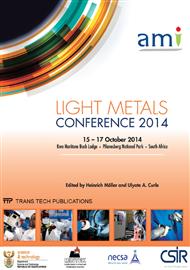p.379
p.385
p.393
p.398
p.406
p.412
p.419
p.426
p.433
Molecular Modelling of the Hydrolysis of Tantalum and Niobium Pentafluoride
Abstract:
Tantalum (Ta) and niobium (Nb) are two metals with similar chemical and physical properties and are found together in nature. One form of Ta is tantalum pentafluoride, which is stable in reducing environments, is corrosive resistant and stable under harsh conditions. Ta is currently used in nuclear reactors with a wide variety of uses and advantages. For these applications, pure Ta is needed to insure high value catalysts, contrary the higher the purity grade the more expensive the production of these high value catalysts. One way of ensuring an economic viable process for the production of high purity Ta, is to find a cost effective way to separate Ta from Nb. Ungerer et al. studied the separation of Ta and Nb, using safer chemicals and techniques for the environment in a solvent extraction (SX) process. During this study, separation was achieved in a sulphuric acid (H2SO4) medium with the extractants diiso-octyl phosphinic acid (PA) and di-(2-ethylhexyl) phosphoric acid (D2EHPA). The main obstacle during this study was the speciation of Ta and Nb, springing the question of why separation occurred with some extractants and not with the others. One method for determining the speciation of the compounds in a reaction mixture is by using computational techniques for molecular modelling. Several molecular modelling programs are available which uses various mathematical equations and approximations. Progress in computational chemistry over the last 20 years has made quantum mechanical calculations on large molecules, chemical systems as well as on macromolecule reactions possible. Calculations based on the density-functional theory (DFT) are now, not only used on light elements and small molecules, but also on metal complexes, heavy metals and especially on metal separation in SX. With these models at hand, SX processes were modelled within realistic margins to fit the experimental setup in a small scale laboratory. It is anticipated that the advances from this work will provide the possibility to determine, with good approximation, the outcome not only of the proposed Ta SX experiments, but also SX in general, before embarking on expensive, time consuming experiments and environmental unfriendly waste generation. In this paper molecular modelling was used to compile a partial energy profile for a proposed reaction mechanism for the reaction of tantalum- and niobium pentafluoride (TaF5, NbF5) with water to form tantalum- and niobium hydroxides. In the process, possible species that may form during the reaction were identified and evaluated.
Info:
Periodical:
Pages:
406-411
Citation:
Online since:
October 2014
Keywords:
Price:
Сopyright:
© 2014 Trans Tech Publications Ltd. All Rights Reserved
Share:
Citation:


